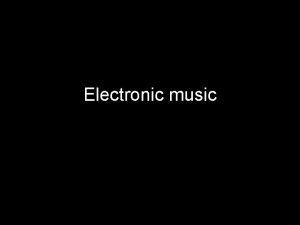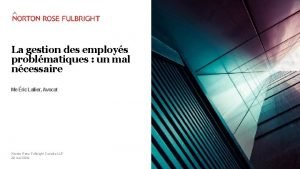Electronic music Electronic music is music that employs










- Slides: 10

Electronic music

• Electronic music is music that employs electronic musical instruments and electronic music technology in its production. In general a distinction can be made between sound produced using electromechanical means and that produced using electronic technology. Examples of electromechanical sound producing devices include the telharmonium, Hammond organ, and the electric guitar. Purely electronic sound production can be achieved using devices such as the Theremin, sound synthesizer, and computer. • Electronic music was once associated almost exclusively with Western art music but from the late 1960 s on the availability of affordable music technology meant that music produced using electronic means became increasingly common in the popular domain. Today electronic music includes many varieties and ranges from experimental art music to popular forms such as electronic dance music.

Origins: late 19 th century to early 20 th century • The ability to record sounds is often connected to the production of electronic music, but not absolutely necessary for it. The earliest known sound recording device was the phonautograph, patented in 1857 by Édouard-Léon Scott de Martinville. It could record sounds visually, but was not meant to play them back. • In 1878, Thomas A. Edison patented the phonograph, which used cylinders similar to Scott's device. Although cylinders continued in use for some time, Emile Berliner developed the disc phonograph in 1887. A significant invention, which was later to have a profound effect on electronic music, was Lee De. Forest's triode audion. This was the first thermionic valve, or vacuum tube, invented in 1906, which led to the generation and amplification of electrical signals, radio broadcasting, and electronic computation, amongst other things. • Before electronic music, there was a growing desire for composers to use emerging technologies for musical purposes. Several instruments were created that employed electromechanical designs and they paved the way for the later emergence of electronic instruments. An electromechanical instrument called the Telharmonium (sometimes Teleharmonium or Dynamophone) was developed by Thaddeus Cahill in the years 1898 -1912. However, simple inconvenience hindered the adoption of the Telharmonium, due to its immense size. The first electronic instrument is often viewed to be the Theremin, invented by Professor Léon Theremin circa 1919– 1920. Other early electronic instruments include the Croix Sonore, invented in 1926 by Nikolai Obukhov, and the Ondes Martenot, which was most famously used in the Turangalîla-Symphonie by Olivier Messiaen as well as other works by him. The Ondes Martenot was also used by other, primarily French, composers such as Andre Jolivet.

2000 s • In recent years, as computer technology has become more accessible and music software has advanced, interacting with music production technology is now possible using means that bear no relationship to traditional musical performance practices: for instance, laptop performance (laptronica) and live coding. In general, the term Live PA refers to any live performance of electronic music, whether with laptops, synthesizers, or other devices. • In the last decade, a number of software-based virtual studio environments have emerged, with products such as Propellerhead's Reason and Ableton Live finding popular appeal. Such tools provide viable and cost-effective alternatives to typical hardware-based production studios, and thanks to advances in microprocessor technology, it is now possible to create high quality music using little more than a single laptop computer. Such advances have democratized music creation, leading to a massive increase in the amount of home-produced electronic music available to the general public via the internet. • Artists such as Fluker from Australia, can now also individuate their production practice by creating personalized software synthesizers, effects modules, and various composition environments. Devices that once existed exclusively in the hardware domain can easily have virtual counterparts. Some of the more popular software tools for achieving such ends are commercial releases such as Max/Msp and Reaktor and open source packages such as Pure Data, Super. Collider, and Chuc. K.

The Knife and Fever Ray • The Knife are an electronic music duo from Sweden, formed in 1999. [2] The group consists of siblings Karin Dreijer Andersson and Olof Dreijer, who together also run their own record company, Rabid Records. They first received international attention after their song "Heartbeats", covered by José González, appeared n a commercial by Sony. Subsequent songs have appeared on a number of television shows. Their first tour took place in 2006, as well as the release of their critically acclaimed album Silent Shout. They have won a number of Swedish Grammis, but refuse to attend awards ceremonies. They have appeared in public wearing Venetian masks. Andersson released a solo album under the name Fever Ray in 2009, while her brother released several EPs as Oni Ayhun in late 2009 and early 2010.

THEODOR BASTARD

Beaver & Krause

Makyo

• • • • Enigma Aeoliah Enya Lesiem Loreena Mc. Kennitt Love Orchestra Jean Ven Robert Hal Kitaro Suzanne Ciani Tangerine Dream Vangelis Ivo Keers Era Yanni

THE END



















